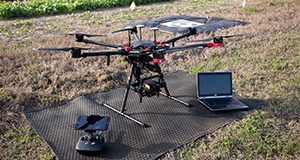With the increasing use of unmanned aerial systems (UASs) in the agricultural domain, ensuring the consistency and completeness of aerial surveys is critical in order to establish repeatability and consistency in data collection activities. This publication covers five main steps to ensure that aerial data collections are repeatable and consistent among missions. It is one of a three-part series focusing on the applications, configuration, and best practices for using UASs in agricultural operations management. Written by Aditya Singh and James Fletcher, and published by the UF/IFAS Department of Agricultural and Biological Engineering, February 2021.
https://edis.ifas.ufl.edu/ae553
Tag: James Fletcher
Applications of Unmanned Aerial Systems in Agricultural Operation Management: Part II: Platforms and Payloads
Unmanned aerial systems (UASs, UAVs, or drones) have emerged as an important tool for farmers, Extension agents, and landowners to map, monitor, and manage their properties. This 5-page publication provides an overview of the primary components of typical UASs to help growers, landowners, and/or Extension agents who want to configure and/or purchase a UAS or sensor system for agricultural operations. This document is one of a three-part series focusing on the applications, configuration, and best practices for using UASs in agricultural operations management. Written by Aditya Singh and James Fletcher, and published by the UF/IFAS Department of Agricultural and Biological Engineering, February 2021.
https://edis.ifas.ufl.edu/ae552
Applications of Unmanned Aerial Systems in Agricultural Operation Management: Part I: Overview
Unmanned aerial systems (UASs, UAVs, or drones) have emerged as one of the most promising technologies for agricultural operation management in recent decades. This 6-page publication provides an overview of the broad areas where UASs can be utilized for monitoring and managing farm operations. Written by James Fletcher and Aditya Singh, and published by the UF/IFAS Department of Agricultural and Biological Engineering, June 2020.
https://edis.ifas.ufl.edu/ae541
A Brief Summary of the Water Bill, SB 552
This 5-page document written by Lisa Krimsky, Andrea Albertin, Charles Barrett, James Fletcher, and Mary Lusk and published by the UF/IFAS Program in Fisheries and Aquatic Sciences of the School of Forest Resources and Conservation is intended to act as a quick reference guide and is not inclusive of all measures in SB 552. This summary addresses the Florida Springs and Aquifer Protection Act, the Central Florida Water Initiative, Northern Everglades and Estuaries Protection, and Pilot Programs for Alternative Water Supply.
http://edis.ifas.ufl.edu/fa205
Collaborative Planning for the Future of Water Resources in Central Florida: Central Florida Water Initiative
Rules and regulations that govern our use of natural resources, specifically water, are changing. Over the past 80 years, Florida’s population increased four times, from approximately 5 million to more than 20 million people. With this population increase, water needs have also increased. Forward-looking communities think about the future of their towns, counties, or the state as they work on redefining regulations to meet future water needs without harming our springs, lakes, rivers, and estuaries. This 4-page fact sheet written by James Fletcher and Tatiana Borisova and published by the Food and Resource Economics Department discusses the Central Florida Water Initiative, which deals with advancing water-use and water-resource-protection strategies for Orlando and its vicinity.
http://edis.ifas.ufl.edu/fe1012

